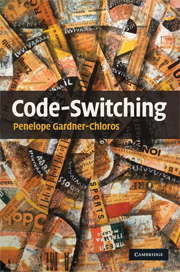Book contents
- Frontmatter
- Contents
- Acknowledgements
- Transcription conventions
- 1 Introduction
- 2 Code-switching and language contact
- 3 Social factors in code-switching
- 4 Code-switching in conversation
- 5 Grammatical aspects of code-switching
- 6 Psycholinguistic approaches
- 7 Acquiring code-switching: code-switching in children (and L2 learners)
- 8 Conclusions
- Appendix
- Bibliography
- Index
6 - Psycholinguistic approaches
Published online by Cambridge University Press: 10 February 2010
- Frontmatter
- Contents
- Acknowledgements
- Transcription conventions
- 1 Introduction
- 2 Code-switching and language contact
- 3 Social factors in code-switching
- 4 Code-switching in conversation
- 5 Grammatical aspects of code-switching
- 6 Psycholinguistic approaches
- 7 Acquiring code-switching: code-switching in children (and L2 learners)
- 8 Conclusions
- Appendix
- Bibliography
- Index
Summary
Introduction
A central argument in this book is that CS forces us to consider questions about what a language is, and that such questions are in turn essential to our understanding of CS. These questions are of interest at a psycholinguistic, as at other levels: if we can understand the mechanisms of the processing, decoding, storage, retrieval and production of linguistic material, we may come closer to understanding how language relates to other cognitive faculties. If it can be established that, with respect to any of these aspects, bilingual functioning is in some material way different from that of monolinguals, then there may be a basis for linking this difference to aspects of bilingual speech – for example, for confirming or rejecting the idea that there is always an underlying “Matrix Language”.
Psycholinguists have accordingly been intrigued by this opportunity to gain a better understanding of how languages are stored in the brain, as well as production mechanisms, and there is a substantial tradition of psycholinguistic research involving bilinguals. As CS is principally a spontaneous and informal phenomenon, however, studying it in its naturally occurring state is largely incompatible with standard psycholinguistic methodological approaches.
The discussion here of psycholinguistic work on bilingualism, from a non-specialist viewpoint, is based on the idea that CS should be considered from a multidisciplinary perspective.
- Type
- Chapter
- Information
- Code-switching , pp. 117 - 141Publisher: Cambridge University PressPrint publication year: 2009



